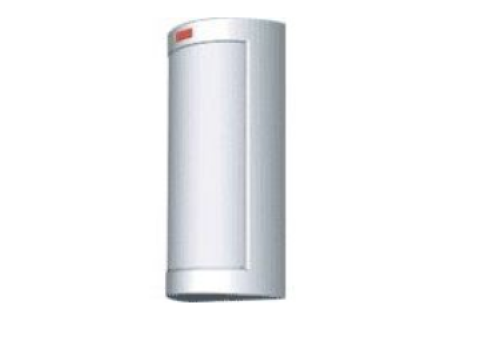Surface (plane) security sensors are specialized devices used exclusively in security alarm systems. Unlike volumetric sensors (motion detectors) or linear beam sensors (perimeter IR beams), these detectors focus on monitoring a specific plane—like a wall, window, or door—to detect attempts at forced entry. They’re often employed in the first line of defense (the perimeter) to catch intruders early, either before or immediately upon breaching a barrier. Below, we’ll examine three main categories:
- Acoustic (Sound-Based) Detectors
- Vibration (Shock) Detectors
- Infrared (Optical-Electronic) “Curtain” Detectors
1. Acoustic (Glass-Break) Detectors
Primary Use
- Glass surfaces (e.g., windows, storefronts) where an intruder might smash through.
- Also suitable for decorative glass doors and partition walls.
How They Work
- Microphone captures the distinctive sound of breaking glass—a low-frequency impact plus high-frequency “shatter.”
- Signal Processing discerns these frequencies to reduce false alarms from normal ambient noises.
Key Considerations
- Maximum Distance & Angle
- Typically up to 20 feet (6 meters) range, with a wide coverage angle (~120°).
- Glass Type & Thickness
- Different glass (tempered, laminated, double-pane) produces different acoustic signatures.
- Check that your chosen sensor supports the specific glass type and thickness.
- Minimum Controllable Surface
- Some sensors have a lower limit on the window area they can reliably detect.
- Very small glass panes, or glass coated with films, may dampen the shattering noise enough to evade detection.
- Installation
- Often ceiling- or wall-mounted.
- Curtains, blinds, or thick drapes can muffle the sound—placing the sensor on the window frame or recess might help.
- Limitations
- No detection for quietly removing glass from the frame (no break).
- May need a secondary sensor (e.g., IR curtain) if intruders can remove glass in one piece.
2. Vibration (Shock) Detectors
Primary Use
- Walls, floors, ceilings, or metal grates vulnerable to physical breach by hammering, drilling, sawing, etc.
- Also used on windows (e.g., older “shock-contact” models) and steel doors.
How They Work
- Piezo or similar vibration sensor monitors surface resonance from impact or drilling.
- The sensor’s zone of coverage is typically circular with a certain radius—some portion of the wall or window is protected.
Key Considerations
- Early Detection
- Vibration sensors can alert security before the barrier is fully penetrated.
- Useful for high-value areas (vaults, safes).
- Potential False Alarms
- Vibrations from passing trucks, construction, or high winds can trigger nuisance alerts.
- Heavier, more rigid surfaces (concrete vs. thin wood) often reduce false positives.
- Coverage & “Blind Spots”
- Since each sensor covers a circular zone, rectangular surfaces may require multiple detectors for full coverage.
- Installing many sensors raises cost and complexity.
- Mounting
- Usually attached directly to the target surface.
- The sensor’s signal processor or transmitter may be in the same housing or separate.
3. Infrared (Optical-Electronic) “Curtain” Detectors
Primary Use
- Indoor (and some outdoor-rated) sensors creating a narrow IR plane—often referred to as a “curtain.”
- Applied to windows, doorways, or along walls where crossing that plane triggers an alarm.
How They Work
- Passive IR technology (or combined IR/MW in some advanced versions) forms a thin detection zone near the protected surface.
- When an intruder crosses the IR field, the detector signals an alarm.
Key Considerations
- Trigger Timing
- Detection occurs once the intruder has entered the room or crossed the IR barrier.
- Not as early as vibration or acoustic (which can trigger on impact).
- Mounting
- Typically near the edge of the surface being protected (e.g., window recess, door frame).
- Must avoid direct sunlight, intense drafts, and large temperature fluctuations to prevent false alarms.
- Range
- Limited to moderate distances, not suited for very large perimeters.
- Supplementary Use
- Often a secondary sensor in conjunction with vibration or acoustic units for comprehensive coverage.
Wired vs. Wireless & Installation
All three sensor types (acoustic, vibration, IR) can come in wired or wireless (radio-channel) versions:
- Wired
- Typically lower cost, more reliable (no battery needed).
- Requires running cables, which can be difficult in finished spaces.
- Wireless
- Quick to install, simpler for retrofits.
- More expensive and dependent on radio range and periodic battery replacement.
Mounting Recommendations
- Acoustic: Ceilings/walls within range of the glass; avoid thick curtains or blinds.
- Vibration: Attach securely to the surface being protected (wall, door, window). Minimizing external noise reduces false alarms.
- IR Curtain: Position so the “sheet” of IR coverage lines up precisely with the plane—avoid obstacles, and ensure stable mounting free from direct sunlight or strong drafts.
Combining Approaches
- Early Stage Detection: Vibration sensors can alert before the intruder fully breaks in.
- Definitive Confirmation: Acoustic picks up the definitive sound of glass breaking.
- Final Barrier: IR curtain triggers once an intruder crosses into the protected area.
Conclusion
Surface detection sensors (acoustic, vibration, and IR curtain) provide a specialized layer of intrusion protection for windows, walls, and doors. They’re particularly well-suited to “first-line” security—detecting or deterring attacks even before an intruder fully gains access. However, each sensor type has unique installation considerations and potential limitations:
- Acoustic: Excellent for glass-break detection, but vulnerable to dampened sounds (e.g., window film).
- Vibration: Early detection of forced entry, but sensitive to environmental vibrations.
- IR Curtain: Triggers on crossing the IR plane; less effective as a purely outer perimeter device yet great for indoor “barrier” coverage.
Successful deployment may involve combining two or more sensor types—or using integrated “hybrid” devices for maximum coverage and minimal false alarms. For help tailoring a surface security sensor solution to your property, visit safsale.com. Our experts can guide you in selecting, installing, and calibrating the right devices for robust and reliable intrusion protection.

